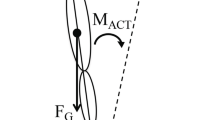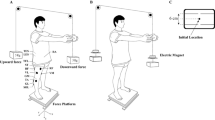Abstract
To address the question of how arm posture is controlled, we analyzed shoulder–elbow unloading responses in the horizontal plane for different directions of the initial load. The initial load, produced by a double-joint manipulandum, was suddenly diminished to 1of 12 randomly presented levels (60 to −10% of the initial load; in 6 out of 12 cases the final load direction varied by ±20°). Subjects were instructed “not to intervene” in response to unloading. Neither the unloading onset nor the final load level was predictable and we assumed that the responses to rapid unloading were involuntary. Unloading elicited a smooth hand movement characterized by a bell-shaped velocity profile. The changes in hand position, joint angles, and joint torques generally increased with greater amounts of unloading. For each direction of the initial load, tonic electromyographic activity of the shoulder and elbow muscles also changed, depending on the amount of unloading. The shoulder and elbow joint torques before and after unloading were a function of the difference between the actual configuration of the arm and its referent configuration (R) described by the angles at which each joint torque was zero. The R configuration changed depending on the direction of the initial load. Our electromyographic data imply that these changes result from a central modification of muscle activation thresholds. The nervous system may thus control the R configuration in a task-specific way by leaving it unchanged to generate involuntary responses to unloading or modifying it to accommodate a new load direction at the same initial position. It is concluded that the R configuration is a major variable in both intentional and involuntary control of posture.











Similar content being viewed by others
References
Adamovich SV, Archambault PS, Ghafouri M, Levin MF, Poizner H, Feldman AG (2001) Hand trajectory invariance in reaching movements involving the trunk. Exp Brain Res 138:288–303
Asatryan DG, Feldman AG (1965) Functional tuning of the nervous system with control of rhythmical movement or maintenance of a steady posture: 1. Mechanographic analysis of the work of the limb on execution of a postural task. Biophysics 10:925–935
Bhushan N, Shadmehr R (1999) Computational nature of human adaptive control during learning of reaching movements in force fields. Biol Cybern 81:39–60
Cesari P, Shiratori T, Olivato P, Duarte M (2001) Analysis of kinematically redundant reaching movements using the equilibrium-point hypothesis. Biol Cybern 84:217–226
Crago PE, Houk JC, Hasan Z (1976) Regulatory actions of human stretch reflex. J Neurophysiol 39:925–935
Domen K, Latash ML, Zatsiorsky VM (1999) Reconstruction of equilibrium trajectories during whole-body movements. Biol Cybern 80:195–204
Dufosse M, Hugon M, Massion J (1985) Postural forearm changes induced by predictable in time or voluntary triggered unloading in man. Exp Brain Res 60:330–334
Fasano G, Franceschini A (1987) Monthly notices of the Royal Astronomical Society, vol 225. pp 155–170
Feldman AG (1966) Functional tuning of the nervous system with control of movement or maintenance of a steady posture II: Controllable parameters of the muscle. Biophysics 11:565–578
Feldman AG (1979) Central and reflex mechanisms in the control of movement. Nauka, Moscow
Feldman AG, Levin MF (1995) The origin and use of positional frames of reference in motor control. Behav Brain Sci 18:723–806
Feldman AG, Orlovsky GN (1972) The influence of different descending systems on the tonic stretch reflex in the cat. Exp Neurol 37:481–494
Feldman AG, Levin MF, Mitnitski AM, Archambault P (1998) 1998 ISEK Congress Keynote Lecture: multi-muscle control in human movements. International Society of Electrophysiology and Kinesiology. J Electromyogr Kinesiol 8:383–390
Flanagan JR, Ostry DJ, Feldman AG (1993) Control of trajectory modifications in target-directed reaching. J Mot Behav 25:140–152
Flash T, Mussa-Ivaldi F (1990) Human arm stiffness characteristics during the maintenance of posture. Exp Brain Res 82:315–326
Gomi H, Kawato M (1997) Human arm stiffness and equilibrium-point trajectory during multi-joint movement. Biol Cybern 76:163–171
Gribble PL, Ostry DJ (2000) Compensation for loads during arm movements using equilibrium-point control. Exp Brain Res 135:474–482
Gribble PL, Ostry DJ, Sanguineti V, Laboissiere R (1998) Are complex control signals required for human arm movement? J Neurophysiol 79:1409–1424
Gunther M, Ruder H (2003) Synthesis of two-dimensional human walking: a test of the lambda-model. Biol Cybern 89:89–106
Hill AV (1951) The influence of temperature on tension developed in an isometric twitch. Proc R Soc Lond [Biol] 139:349–354
Houk JC (1976) An assessment of stretch reflex function. Prog Brain Res 44:303–314
Kawato M (1999) Internal models for motor control and trajectory planning. Curr Opin Neurobiol 9:718–727
Lacquaniti F, Soechting JF (1986) Responses of mono- and bi-articular muscles to load perturbations of the human arm. Exp Brain Res 65:135–144
Latash ML (1994) Reconstruction of equilibrium trajectories and joint stiffness patterns during single-joint voluntary movements under different instructions. Biol Cybern 71:441–450
Latash ML, Aruin AS, Zatsiorsky VM (1999) The basis of a simple synergy: reconstruction of joint equilibrium trajectories during unrestrained arm movements. Hum Mov Sci 18:3–30
Lestienne FG, Thullier F, Archambault P, Levin MF, Feldman AG (2000) Multi-muscle control of head movements in monkeys: the referent configuration hypothesis. Neurosci Lett 283:65–68
Levin MF, Dimov M (1997) Spatial zones for muscle coactivation and the control of postural stability. Brain Res 757:43–59
Lieber RL, Friden J (1999) Mechanisms of muscle injury after eccentric contraction. J Sci Med Sport 2:253–265
Mah CD (2001) Spatial and temporal modulation of joint stiffness during multijoint movement. Exp Brain Res 136:492–506
Massion J (1992) Movement, posture and equilibrium: interaction and coordination. Prog Neurobiol 38:35–56
Matthews PBC (1959) A study of certain factors influencing the stretch reflex of the decerebrate cat. J Physiol 147:547–564
Mussa-Ivaldi FA, Hogan N, Bizzi E (1985) Neural, mechanical, and geometric factors subserving arm posture in humans. J Neurosci 5:2732–2743
Nichols TR (1989) The organization of heterogenic reflexes among muscles crossing the ankle joint in the decerebrate cat. J Physiol 410:463–477
Nichols TR, Steeves JD (1986) Resetting of resultant stiffness in ankle flexor and extensor muscles in the decerebrate cat. Exp Brain Res 62:401–410
Ostry DJ, Feldman AG (2003) A critical evaluation of the force control hypothesis in motor control. Exp Brain Res 153:275–288
Ostry DJ, Gribble PL, Levin MF, Feldman AG (1997) Phasic and tonic stretch reflexes in muscles with few muscle spindles: human jaw-opener muscles. Exp Brain Res 116:299–308
Osu R, Franklin DW, Kato H, Gomi H, Domen K, Yoshioka T, Kawato M (2002) Short- and long-term changes in joint co-contraction associated with motor learning as revealed from surface EMG. J Neurophysiol 88:991–1004
Peacock JA (1983) Monthly Notices of the Royal Astronomical Society, vol 202. pp 615–627
Popescu FC, Rymer WZ (2000) End points of planar reaching movements are disrupted by small force pulses: an evaluation of the hypothesis of equifinality. J Neurophysiol 84:2670–2679
Scholz JP, Schoner G (1999) The uncontrolled manifold concept: identifying control variables for a functional task. Exp Brain Res 126:289–306
Scholz JP, Schoner G, Latash ML (2000) Identifying the control structure of multijoint coordination during pistol shooting. Exp Brain Res 135:382–404
Shadmehr R, Mussa-Ivaldi FA (1994) Adaptive representation of dynamics during learning of a motor task. J Neurosci 14:3208–3224
Shadmehr R, Mussa-Ivaldi FA, Bizzi E (1993) Postural force fields of the human arm and their role in generating multijoint movements. J Neurosci 13:45–62
St-Onge N, Adamovich SV, Feldman AG (1997) Control processes underlying elbow flexion movements may be independent of kinematic and electromyographic patterns: experimental study and modelling. Neuroscience 79:295–316
Tsuji T, Morasso PG, Goto K, Ito K (1995) Human hand impedance characteristics during maintained posture. Biol Cybern 72:475–485
Von Holst E (1950/1973) Daz reafferezprincip: Wechselwirkungen zwischen Zentralnerven-system und Peripherie. In: Martin R (ed) The behavioural physiology of animals and men; the collected papers of Erich Von Holst, vol 1. University of Miami Press, Coral Gables, pp 139–173
Wolpert DM, Miall RC, Kawato M (1998) Internal models in the cerebellum. Trends Cognit Sci 2:338–347
Acknowledgements
This work was supported by FRSQ (Fonds de Recherche en Santé du Québec, Canada), CIHR (Canadian Institutes of Health Research, Canada) and NSERC (Natural Science and Engineering Council, Canada). We would like to thank Dr David Ostry for his helpful comments on the paper.
Author information
Authors and Affiliations
Corresponding author
Rights and permissions
About this article
Cite this article
Archambault, P.S., Mihaltchev, P., Levin, M.F. et al. Basic elements of arm postural control analyzed by unloading. Exp Brain Res 164, 225–241 (2005). https://doi.org/10.1007/s00221-005-2245-6
Received:
Accepted:
Published:
Issue Date:
DOI: https://doi.org/10.1007/s00221-005-2245-6




